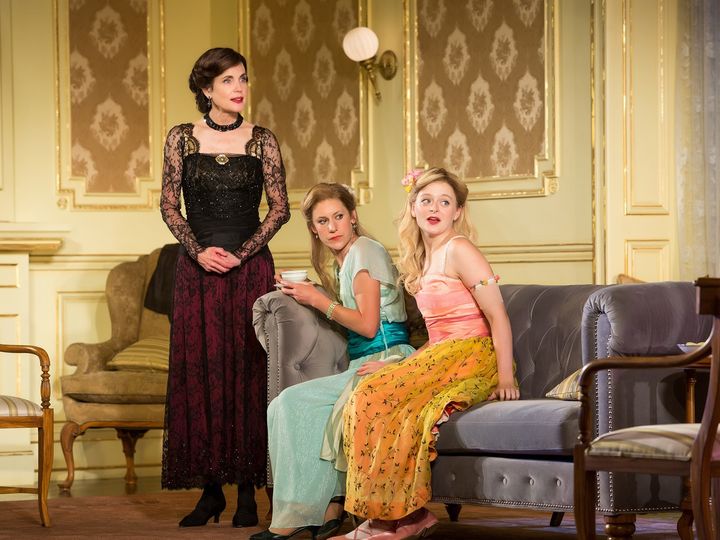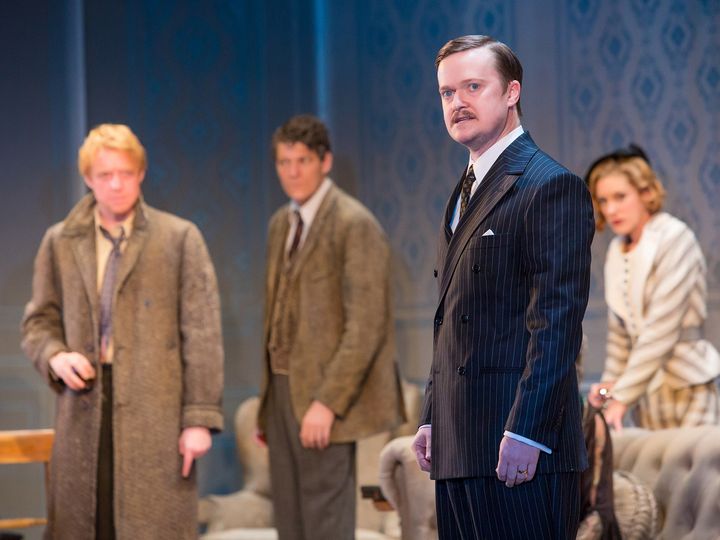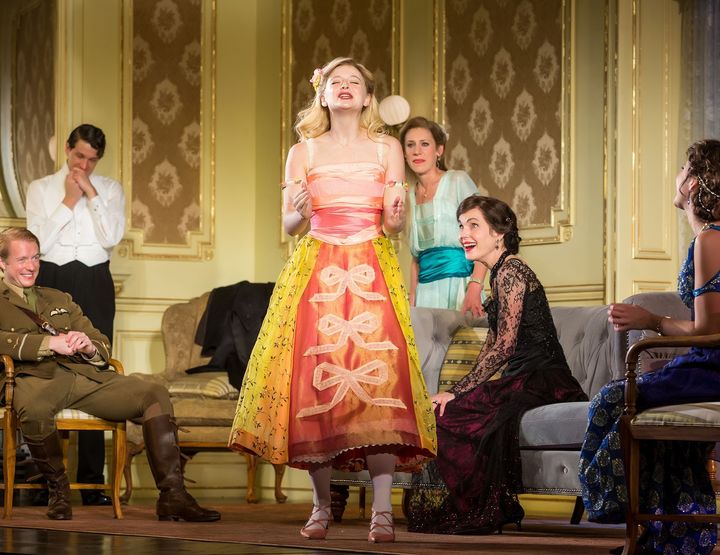
Elizabeth McGovern, Charlotte Parry and Anna Baryshnikov in Time and the Conways
Time is decidedly not good to the Conways, the cultured pearl-edged family of upper-crusters whom we meet in Act I of J.B. Priestley’s 1937 drama Time and the Conways (at the Roundabout). The Great War has just ended, and as the action begins the golden-boy son returns from the front. A return to normalcy, no?
Well, no. Every dream of tomorrow—in the 1919 scene (originally the first act of three, although the first two acts are here played sans intermission)—is described in such a manner that a knowing audience instantly realizes that these pipe dreams are flimsy as pipe cleaners. The action moves to 1937, at which point the family fortune is on the verge of cataclysm. For his final act, Priestley has one of his typical, time-tricked surprises for us which tie the play together and highlight his theme.
If time is not good to the Conways, it proves just as troublesome to Time and the Conways. This is one of those old-fashioned plays, which in this case means that the first twenty minutes or so is steeped in exposition as each of six Conway siblings comes on to tell us all about themselves, and seemingly all about their siblings. And dear old mother, of course, and she’s what one might call “a piece of work.” This during a rather odd birthday party which takes place off-stage in the next room, with the family running in and out while the unseen guests play charades.
Priestley is nothing if not unsubtle. The kids grab funny costumes and funny mustaches (though, thankfully, no out-of-period “Groucho” mustaches) from an old trunk packed with funny costumes and funny mustaches. As an example of clumsy exposition, one of the gals suddenly pulls a jacket out of the trunk and goes ashen; this is “the coat Father wore just before he was drowned”! Plot point!! But why, you might ask, is papa’s death coat mixed in with masquerade costumes?? Simply, it seems, because this was the easiest way for the playwright to tell us that beloved papa was dead and would overshadow the Conways for all time. Which is typical of the exposition-packed first act.

Steven Boyer (foreground) in Time and the Conways
Priestley’s time tricks help matters, eventually, and somewhat make up for the talky and not very interesting start. But the play does not make a compelling case for itself. The author’s 1945 play, An Inspector Calls, has tricks of its own; but is far more effective, as evidenced by Stephen Daldry’s production which took London (1992) and Broadway (1994) by storm. Priestley was an important British voice of his time, although he seems to have outworn his welcome and political influence as a vehement left-winger.
That said, Priestley’s most enduring work predated his dozen plays: the 1929 novel The Good Companions remains what might be the most delectably readable show business chronicle of the century. While it has been adapted for stage, screen, musical comedy and even mini-series, anyone interested in the lore of theatricals is urged to find a copy of the novel and prepare to bask in bliss through the intertwined tales of Inigo, Miss Trant and Old Jess.
The Roundabout production has been well-staged by Rebecca Taichman, who won a Tony for her Broadway debut last spring with Indecent; and the play is especially well served by designers Neil Patel (sets), Paloma Young (costumes) and Christoper Akerlind (lights). The actors do their best, I suppose, but are in some cases defeated by the material. Most effective are Gabriel Ebert (a Tony winner for Matilda) as the least-flashy of the Conways, and Steven Boyer (of Hand of God) as the shy underclass bloke who in time overtakes them all. Ebert seems to just stand there most of the play, with relatively little to say; but he is very much in every scene, observing (while decidedly not participating) so intensely that we somehow feel more for his character than the rest. As for Boyer, in the 1937 scene—helped by a wonderfully aggressive suit of clothes from Young—he turns every bit as severe as that puppet he was attached to in his last play.
Strongest of the others is Anna Baryshnikov, daughter of you-know-who, as the youngest Conway. She is bright and refreshing in the early stages, and effectively pulls off the play’s mystical device. Anna Camp, Brooke Bloom and Matthew James Thomas (as the other siblings) are constrained by the printed page, while Charlotte Parry acts much more than Ebert to much less effect.
The main event of the evening, as it were, is the stage return of Elizabeth McGovern, a one-time Juilliard actor who was whisked to Hollywood in 1980 (for Ordinary People and Ragtime) and has spent most of her career on screens big and small. As Mrs. Conway, she makes a menacing mother, at once doting and smothering. McGovern handles this well, but the performance might seem more effective if we had not spent six seasons watching her as the lady of the manor at Downton Abbey. Which is to say, a fair amount of Mrs. Conway’s actions and reactions look like we’ve seen them before (because we have seen them before).

Anna Baryshnikov and Elizabeth McGovern (center) in Time and the Conways
Thanks in great part to director Taichman and the designers, this revival of Time and the Conways is interesting enough. If it’s an “interesting enough” time you’re looking for.
The Roundabout production of J.B. Priestley’s “Time and the Conways” opened October 10, 2017 and continues through November 26 at the American Airlines Theatre
